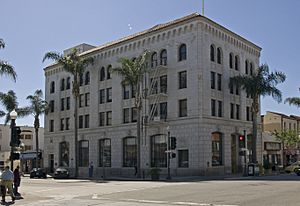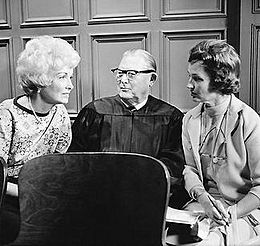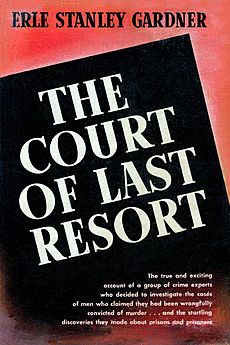Erle Stanley Gardner facts for kids
Quick facts for kids
Erle Stanley Gardner
|
|
|---|---|

Gardner in 1966
|
|
| Born | July 17, 1889 Malden, Massachusetts, U.S. |
| Died | March 11, 1970 (aged 80) Temecula, California, U.S. |
| Pen name | A.A. Fair, Carl Franklin Ruth, Carleton Kendrake, Charles M. Green, Charles J. Kenny, Della Street, Edward Leaming, Grant Holiday, Kyle Corning, Les Tillray, Robert Parr, Stephen Caldwell |
| Occupation | Lawyer, writer |
| Education |
|
| Genre | Detective fiction, true crime, travel writing |
| Notable works |
|
| Notable awards |
|
| Spouse |
Natalie Frances Talbert
(m. 1912; died 1968)Agnes Jean Bethell
(m. 1968) |
| Children | 1 |
| Signature | |
 |
|
Erle Stanley Gardner (born July 17, 1889 – died March 11, 1970) was a famous American lawyer and author. He is most known for his exciting Perry Mason series of detective stories. He also wrote many other novels and short stories. Besides fiction, he wrote non-fiction books about his travels, especially through Baja California in Mexico.
At the time of his death, Gardner was the best-selling American author of the 20th century. He used many different pen names, also called pseudonyms. Some of these were A.A. Fair, Carleton Kendrake, and even Della Street, who was a character in his own books!
Contents
Becoming a Writer and Lawyer
Erle Stanley Gardner was born in Malden, Massachusetts. He finished high school in Palo Alto, California, in 1909. He then went to Valparaiso University School of Law in Indiana. However, he left after about a month because he was more interested in boxing!
He returned to California and studied law on his own. In 1911, he passed the California State Bar examination. This meant he could become a lawyer.
Starting His Legal Career
Gardner began his legal career as a typist at a law firm. After becoming a lawyer, he worked as a trial lawyer. He often defended people who were poor, especially immigrants from China and Mexico.
This experience led him to create something very important: the Court of Last Resort.
The Court of Last Resort
In the 1940s, Gardner started the Court of Last Resort. This organization helped people who were unfairly put in prison. It also helped those who did not get a fair trial.
This group was one of the first to stand up for people who were wrongly convicted. Today, other groups like The Innocence Project do similar important work.
Balancing Law and Writing
In 1912, Gardner married Natalie Frances Talbert. They had one daughter, Grace. He opened his first law office in Merced in 1917. Later, he joined a law firm in Ventura. He stayed there until his first Perry Mason novel was published in 1933.
Gardner liked being a lawyer, especially planning trial strategies. But he found other parts of legal work boring. So, in his free time, he started writing stories for magazines.
Writing for Pulp Magazines
His first story, The Police in the House, was published in 1921. He wrote many series characters for these magazines, often called "pulp magazines." These magazines were popular for their exciting, action-packed stories.
Gardner set a goal to write 1,200,000 words a year! At first, he typed his stories himself. Later, he dictated them to a team of secretaries.
Creating Famous Characters
Gardner created many famous characters. One was Lester Leith, a clever "gentleman thief." Another was Ken Corning, a lawyer and detective. Ken Corning was an early version of his most successful character, Perry Mason.
- Perry Mason: The Perry Mason novels were full of exciting plot details. Gardner used his own experiences as a lawyer to make the stories feel real.
- A.A. Fair: Under the name A.A. Fair, Gardner wrote a series of novels about the private detective firm Cool and Lam.
- Doug Selby: In another series, district attorney Doug Selby was the hero. He solved crimes and went against a tricky lawyer named Alphonse Baker Carr.
The Success of Perry Mason
The first Perry Mason novel, The Case of the Velvet Claws, came out in 1933. Much of the story takes place near Gardner's old law office in Ventura, California.
In 1937, Gardner moved to Temecula, California, where he lived for the rest of his life. The Perry Mason series became very popular, with more than 80 novels! As his books became more successful, he wrote less for the pulp magazines.
Perry Mason on Screen and Radio
Perry Mason became a character in Hollywood films in the 1930s. He also had his own radio program, which ran from 1943 to 1955.
In 1957, Perry Mason became a very popular TV show on CBS. Raymond Burr starred as Perry Mason. Gardner himself even made a short appearance as a judge in the very last episode of the series in 1966.
The character of Perry Mason was inspired by a real lawyer named Earl Rogers. Rogers was known for using visuals like charts and diagrams in court. This was very new at the time!
Travel Writing and Other Works
Gardner loved Baja California. He wrote many non-fiction travel books about his adventures exploring the area. He traveled by boat, truck, airplane, and helicopter.
His book about the Court of Last Resort, published in 1952, won him an Edgar Award. This award is given for excellent mystery writing. The book was also made into a TV series called The Court of Last Resort.
Personal Life
In 1912, Erle Stanley Gardner married Natalie Frances Talbert. Their only child, Natalie Grace Gardner, was born in 1913. Gardner and his wife separated in the early 1930s. However, they remained married for 56 years until Natalie's death in 1968.
After Natalie passed away, Gardner married his secretary, Agnes "Jean" Bethell, in 1968.
Death and Legacy
Erle Stanley Gardner died from cancer on March 11, 1970, at his ranch in Temecula. At the time of his death, he was the best-selling American writer of the 20th century.
His ashes were scattered over his beloved Baja California peninsula. His ranch was later sold and is now part of the Pechanga reservation.
Gardner's original writings, art collection, and personal items are kept at the Harry Ransom Center at the University of Texas at Austin. In 2003, a new school in Temecula was named Erle Stanley Gardner Middle School in his honor.
In recent years, some of Gardner's lost books have been published. For example, The Knife Slipped, a Cool and Lam mystery, was found and published in 2016, 75 years after it was written!
Images for kids
See also
 In Spanish: Erle Stanley Gardner para niños
In Spanish: Erle Stanley Gardner para niños




